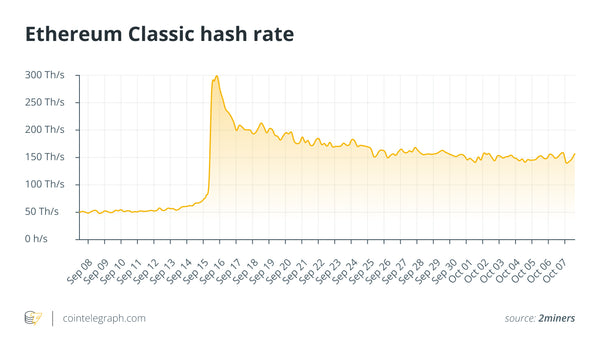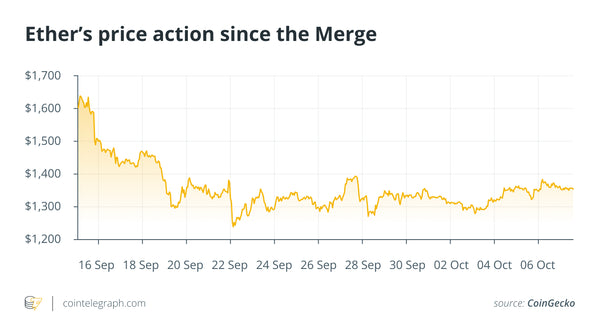
Source:COINTELEGRAPH
The prices of many popular GPUs, such as Nvidia’s RTX3080, have dropped by nearly 60% over the last 90 days across some parts of the globe.
Ethereum’s long-awaited transition to a proof-of-stake (PoS) consensus mechanism kicked off on Sept. 15, thus finally putting its long-standing transaction woes in the rearview mirror. To this point, the network is now capable of processing anywhere between 20,000–100,000 transactions per second (tps) as opposed to its previous rate of just 30 tps.
Furthermore, the Merge also saw the Ethereum network become up to 99.9% more energy efficient as compared to its previous iteration, thus allaying fears of its excessive energy consumption, a criticism that still lingers quite heavily in relation to Bitcoin (BTC).
Amid these developments, however, a question that has continued to pique the interest of many crypto enthusiasts: “What happens to the graphics processing unit market now that the transition has concluded?”
It is worth noting that following the Merge, the blockchain transitioned from its energy-intensive proof-of-work (PoW) mechanism to a PoS framework. As a result, miners that used to process transactions and produce blocks were replaced by ecosystem participants who can now stake their Ether
Ethereum’s long-awaited transition to a proof-of-stake (PoS) consensus mechanism kicked off on Sept. 15, thus finally putting its long-standing transaction woes in the rearview mirror. To this point, the network is now capable of processing anywhere between 20,000–100,000 transactions per second (tps) as opposed to its previous rate of just 30 tps.
Furthermore, the Merge also saw the Ethereum network become up to 99.9% more energy efficient as compared to its previous iteration, thus allaying fears of its excessive energy consumption, a criticism that still lingers quite heavily in relation to Bitcoin (BTC).
Amid these developments, however, a question that has continued to pique the interest of many crypto enthusiasts: “What happens to the graphics processing unit market now that the transition has concluded?”
It is worth noting that following the Merge, the blockchain transitioned from its energy-intensive proof-of-work (PoW) mechanism to a PoS framework. As a result, miners that used to process transactions and produce blocks were replaced by ecosystem participants who can now stake their Ether and ETHW, a PoW fork of ETH that went live after the upgrade, alongside other mining projects, while 660TH/s was shut down temporarily.

Alluding to ETC’s above-shown hash rate chart, White noted that the incoming hashing power seems to have been exiting the network gradually since mid-Sept i.e., the time of the Merge. In this regard, it is speculated that the price of ETC did not rise as expected, with the influx of this computing power leading several miners to shut down their operations permanently. White added:
“This shows that the cryptocurrency mining market has a huge number of idle GPUs and the revenue from traditional mining cannot support their running costs, so they are shutting down and facing the choice of waiting for new mining opportunities or selling them second-hand.”
He further claimed that many used NVIDIA 30 series GPUs have recently entered the secondary market for sale, decreasing the price of GPUs even more. However, as potentially lucrative minable coins continue to enter the market in the near term, White believes that these GPUs may once again find utility.
What lies ahead for the GPU market?
As is evident by now, the Ethereum Merge has served as a major technical and industrial upgrade for the cryptocurrency mining sector as a whole. Providing his take on the matter, Ilman Shazhaev, founder and CEO for blockchain gaming metaverse Farcana, told Cointelegraph that despite this apparent setback, the GPU industry is now an evergreen niche, especially with the continued emergence of different PoW protocols with each passing day:
“Despite the transition, there is no reduction in the number of protocols that needs GPUs, and this will help sustain the demand for these devices in the near future. Also, with the gradual embrace of metaverse-centric innovations, the demand for GPUs, which are a key component of most gaming consoles, will be sustained.”
In White’s opinion, GPUs will not become much cheaper anytime soon, with their prices most likely having stabilized around their current rates. In fact, he believes that the price changes we are witnessing now had “already been factored” in before the Merge, adding that to build momentum for the launch of their upcoming GPUs, manufacturers like Nvidia had already started clearing out their inventories sometime ago. He said:“I believe the price of used GPUs will slowly decline, and low-end GPUs will probably go extinct from the market altogether. On the other hand, I believe demand for high-end GPUs will increase.”
Lastly, it should be noted that, in a scenario where there are no tokens to mine, it stands to reason that GPU prediction rates will also be affected, with most manufacturers most likely reverting back to their “order-based production” processes since the mining boom of the last few years had led to massive stockpiling.
ETH price action lackluster despite efficiency increase
As noted previously, with the conclusion of the Merge, Ethereum’s energy consumption has gone down by a staggering 99.9%, resulting in a 0.2% reduction in global power consumption. Despite these significant developments, however, ETH’s price action has been extremely poor, almost unexpected in the eyes of many.

As can be seen from the chart above, since Sept. 16, the altcoin has slipped from $1,630 to its current price point of $1,330, showcasing a loss of approximately. 22%. In this regard, experts believe that this lack of positive price momentum could be due to upward movements having already been priced into the currency’s value a couple of weeks before the upgrade.
Thus, even though the Ethereum network has gotten rid of GPU mining completely, some sections of miners may still attempt to keep their cash-cow running, as is made evident by the fact that several proposals to copy the Ethereum blockchain, such as ETHW — while retaining mining capabilities — have gained some traction. That being said, while it is quite easy to develop such a token, it is extremely hard to convince people to use it. Therefore, it will be interesting to see how the future of Ethereum’s various PoW hard forks and the GPU market continues to unfold from here on out.





